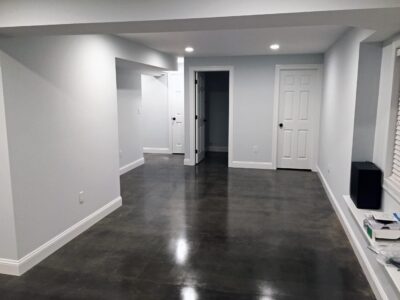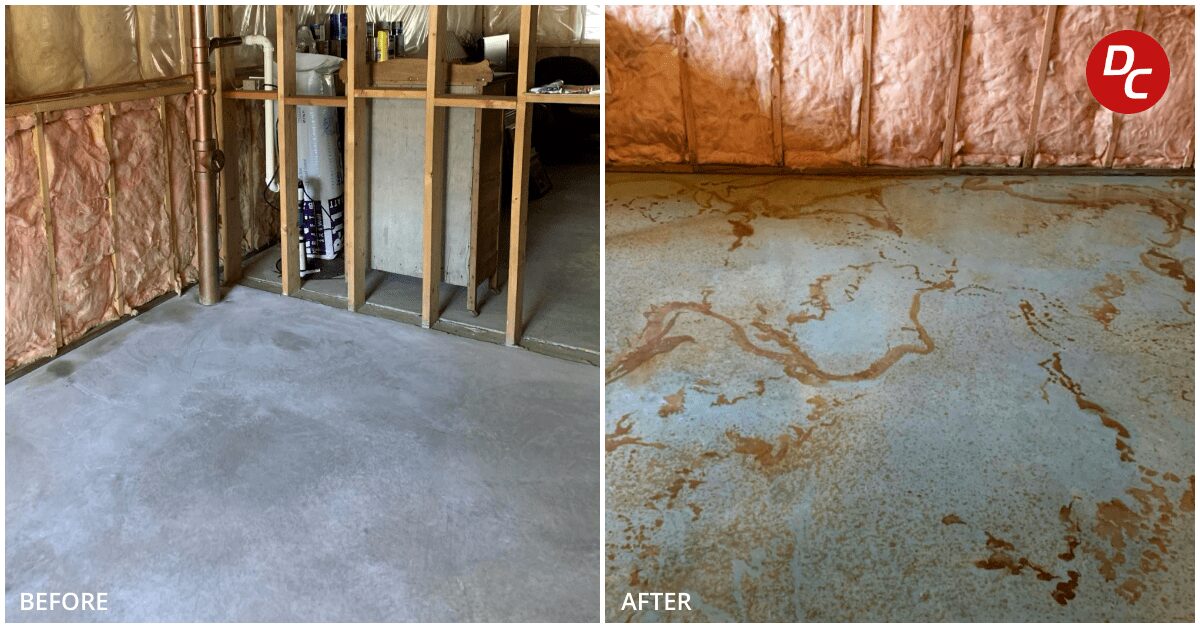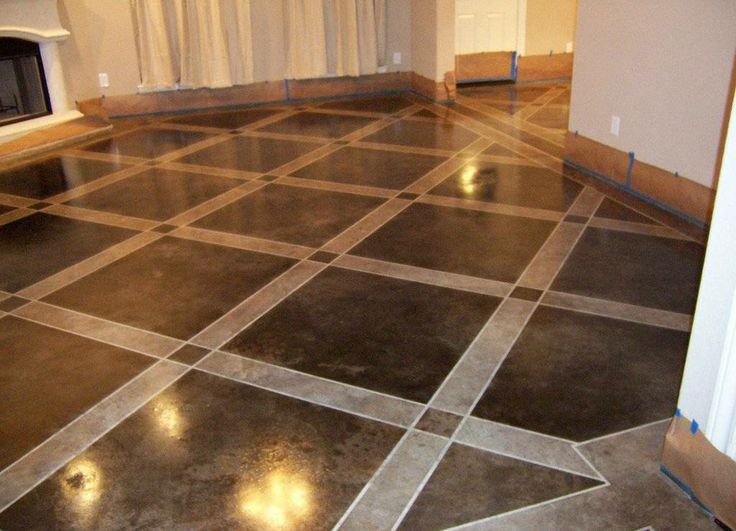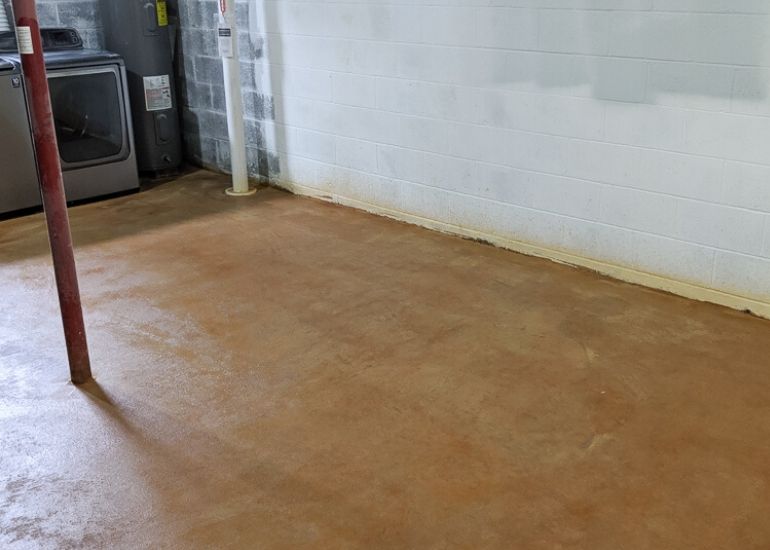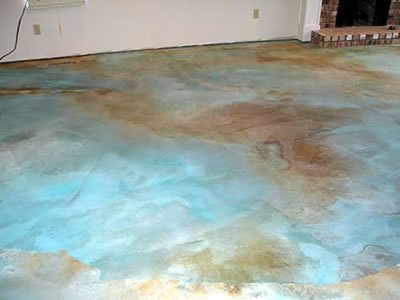Staining a basement floor is an excellent way to enhance the space, adding both visual appeal and functionality to an often underutilized area of the home. One of the primary benefits of staining concrete basement floors is the wide range of design possibilities it offers. Whether you’re aiming for a sleek, modern look or something more rustic and textured, there’s a stain option to suit your style. Acid-based stains, for example, react with the minerals in the concrete to produce rich, variegated colors that resemble natural stone. These stains create a unique, mottled effect that can add depth and character to your basement floor, making it a focal point rather than an afterthought. Water-based stains, on the other hand, offer a broader color palette and can be layered or mixed to achieve custom hues that align with your overall design scheme. The versatility of these stains allows you to create anything from a minimalist concrete floor to one that mimics the look of marble, wood, or even leather.
Images about Basement Floor Stain Ideas
Basement Floor Stain Ideas
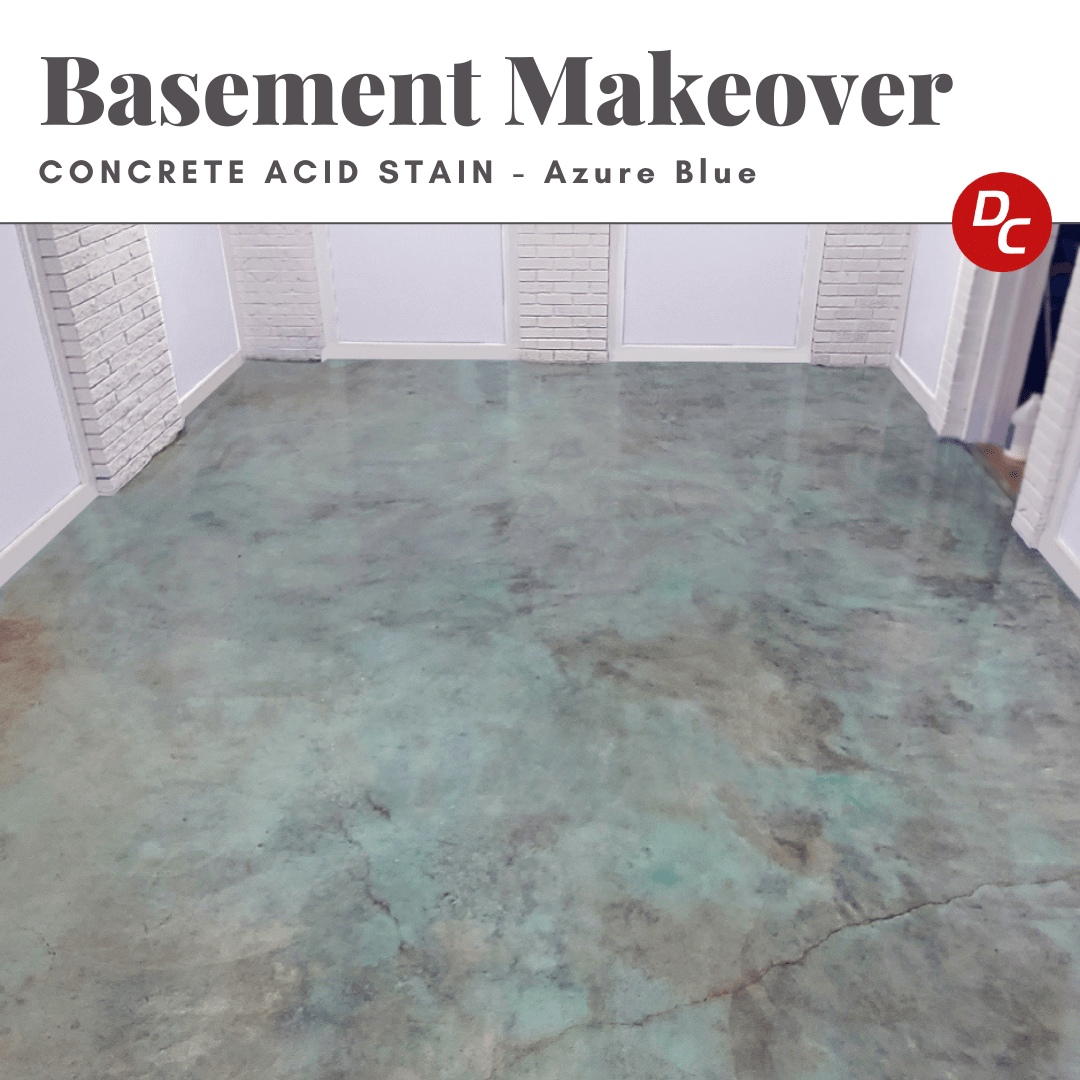
Beyond aesthetics, stained concrete floors in basements offer practical benefits that make them an ideal choice for this part of the home. Basements are often prone to moisture and humidity, and traditional flooring materials like carpet or wood can easily become damaged in these conditions. Stained concrete, however, is highly resistant to moisture, mold, and mildew, making it a durable and low-maintenance option. The stain penetrates the concrete surface, becoming a permanent part of the floor, which means it won’t peel or chip over time. Additionally, a sealed stained floor creates a barrier that protects the concrete from water penetration and spills, further enhancing its longevity. This durability, combined with the ease of cleaning—a simple sweep and mop will usually suffice—makes stained concrete an excellent long-term investment for basement flooring.
One of the more creative ideas for stained basement floors is to use patterns and designs to elevate the space’s aesthetic appeal. Techniques such as scoring, stenciling, or engraving can be used in combination with staining to create intricate designs that mimic the look of tiled floors or other more expensive materials. For example, a scored grid pattern combined with a stain that mimics the appearance of slate can give the illusion of a stone-tiled floor at a fraction of the cost. Alternatively, you could use stencils to create borders, medallions, or even custom logos that add a personal touch to the basement space. These design elements can transform a plain concrete floor into a work of art, making the basement not just functional but also a stylish extension of your home’s living area.
In addition to its decorative and practical advantages, staining a basement floor is also a cost-effective flooring solution. Compared to other flooring options like hardwood, tile, or carpet, stained concrete is relatively inexpensive to install and maintain. Since the concrete slab is already part of the basement structure, there’s no need for additional subflooring, which reduces both material and labor costs. The staining process itself is straightforward and can often be completed by a skilled DIYer, further saving on installation expenses. Once the floor is stained and sealed, ongoing maintenance costs are minimal, as the floor is highly durable and resistant to damage. This affordability, combined with the ability to achieve high-end looks at a lower cost, makes stained concrete an attractive option for homeowners looking to maximize their investment in basement renovations. Whether you’re finishing a basement for additional living space, a home gym, or a recreational area, stained concrete floors provide a stylish, durable, and economical foundation that will serve you well for years to come.
Acid Stained Hard Troweled Concrete Floor Direct Colors
Acid Stained Basement Floor
inexpensive basement finishing
Painted Concrete Floors, Concrete Floor Paint
The Ultimate Guide to Staining a Basement Floor – Semigloss Design
The Best Concrete Stain Designs for Your Basement
Stained Concrete Floors – Benefits, Colors
Basement with a Stained Concrete Floor Basement stained concrete
Related Posts:
- Basement Floor Insulation Panels
- Best Flooring For Basement Floor
- Basement Floor Paint
- Basement Flooring Paint
- Vinyl Tile For Basement Floor
- Basement Floor Refinishing
- Cheap Basement Flooring
- Basement Floor Resurfacing
- Redo Basement Floor
- Cheap Flooring For Basement
Basement Floor Stain Ideas: Transform Your Home in Style
Few of us take the time to consider how far a little bit of floor stain can go in transforming our basements. Whether you’re looking to add a touch of luxury to your home, or simply want to give your basement a much-needed facelift, staining your basement floor is an easy and inexpensive way to do so. Fortunately, there are many basement floor stain ideas that you can choose from to achieve the look you desire.
Types of Basement Floor Stains
When it comes to choosing the right type of stain for your basement floor, there are several options available. The most popular types of basement stains include water-based, oil-based, and acid-based stains. Each type of stain has its advantages and disadvantages, so it’s important to choose the one that best suits your needs.
Water-Based Stains
Water-based stains are one of the most popular choices when it comes to staining basement floors. These stains are easy to apply and generally provide better coverage than other types of stains. Additionally, water-based stains dry quickly and are low odor and nonflammable, making them a safe choice for basements. However, water-based stains don’t last as long as oil-based stains, so you may need to reapply them more often.
Oil-Based Stains
Oil-based stains are another popular choice for staining basement floors, as they provide a longer-lasting finish than water-based stains. Oil-based stains also have a low odor and are nonflammable, making them a safe choice for basements. However, oil-based stains can be difficult to apply and require more time to dry than water-based stains. Additionally, they’re flammable and can be hazardous if not properly applied and cleaned up after use.
Acid-Based Stains
Acid-based stains are a great option for those looking for a more permanent solution to their basement floor staining needs. Acid-based stains provide a deep, long-lasting finish that won’t fade or wear off easily. However, these stains require more skill to apply correctly and can be hazardous if not used properly. Additionally, acid-based stains have an unpleasant odor and can be flammable if not properly handled.
Popular Basement Floor Stain Ideas
Once you’ve chosen the right type of stain for your basement floor, it’s time to decide on the perfect color or design for your basement floor. Here are some of the most popular basement floor stain ideas:
• Dark Wood – Dark wood stains are perfect for creating a warm and inviting atmosphere in your basement. Choose from shades such as walnut, mahogany, or cherry for a classic look that will never go out of style.
• Light Wood – If you want to brighten up your basement without sacrificing style, light wood stains are the perfect choice. Choose from shades such as maple, oak, or pine for an airy and open feel in your space.
• Solid Colors – Solid colors are an easy way to instantly transform your basement. Popular choices include black, white, gray, and brown for a sleek and modern look.
• Faux Finishes – Faux finishes such as marbling or faux wood can add texture and depth to your basement floor. Choose from shades such as tan or cream for a subtle yet sophisticated look.
• Metallic Stains – Metallic stains are perfect for creating an industrial or modern look in your basement. Popular metallic shades include silver, bronze, copper, gold, and steel for a unique touch.
• Custom Designs – If you’re feeling creative, you can create custom designs on your basement floor with stencils or other tools. Try creating stripes or polka dots for a fun and whimsical look that will make any guest smile!
